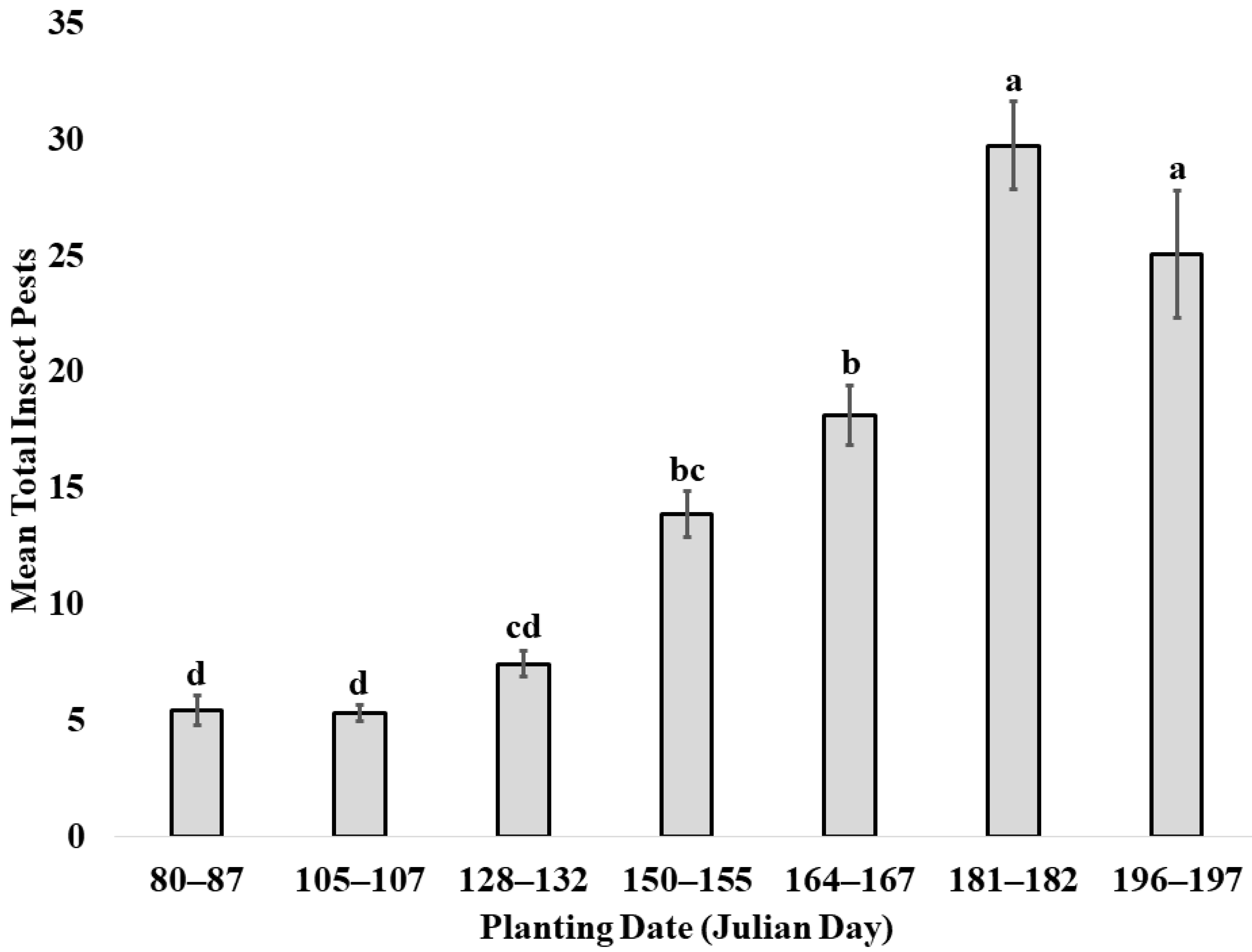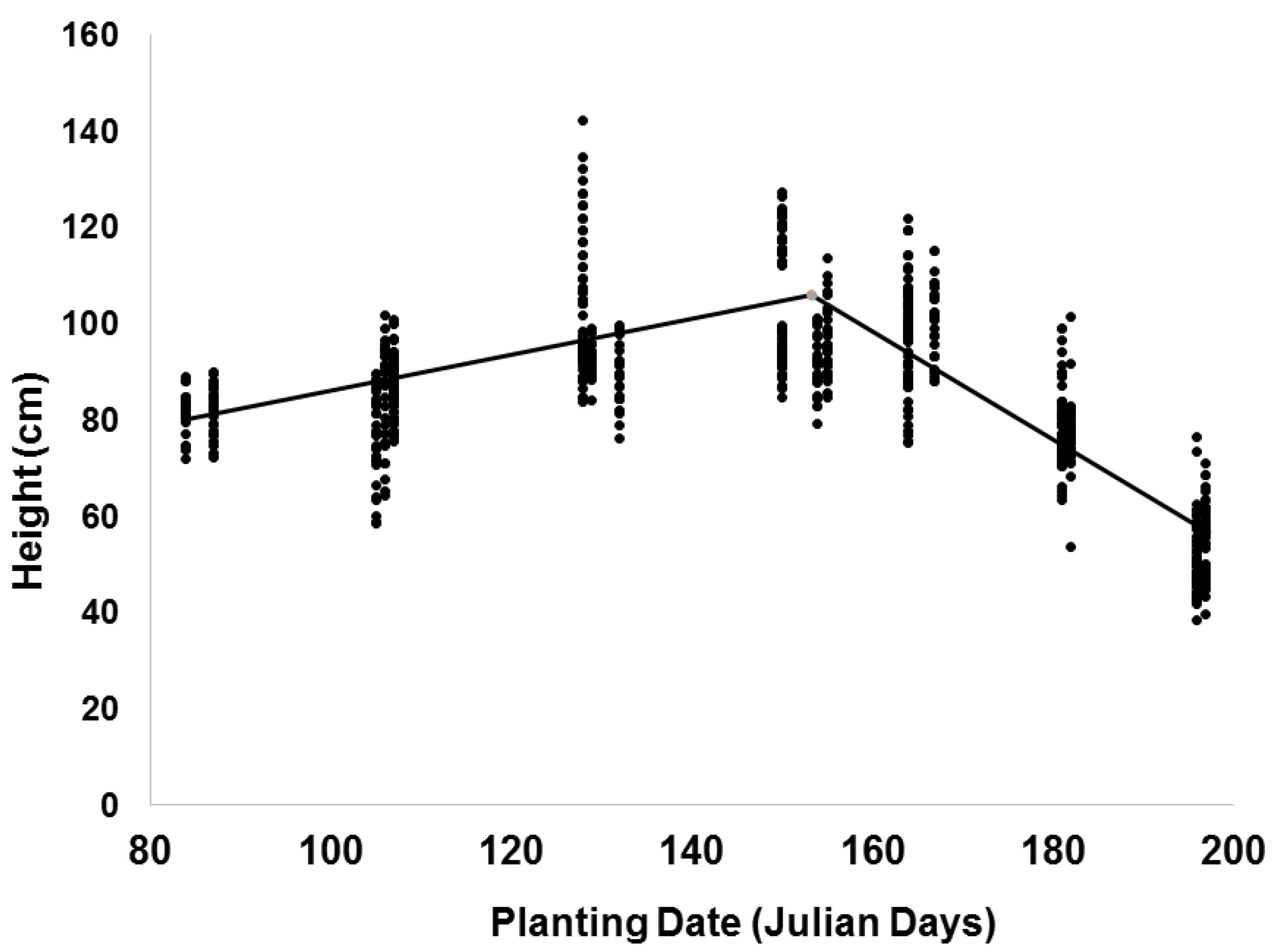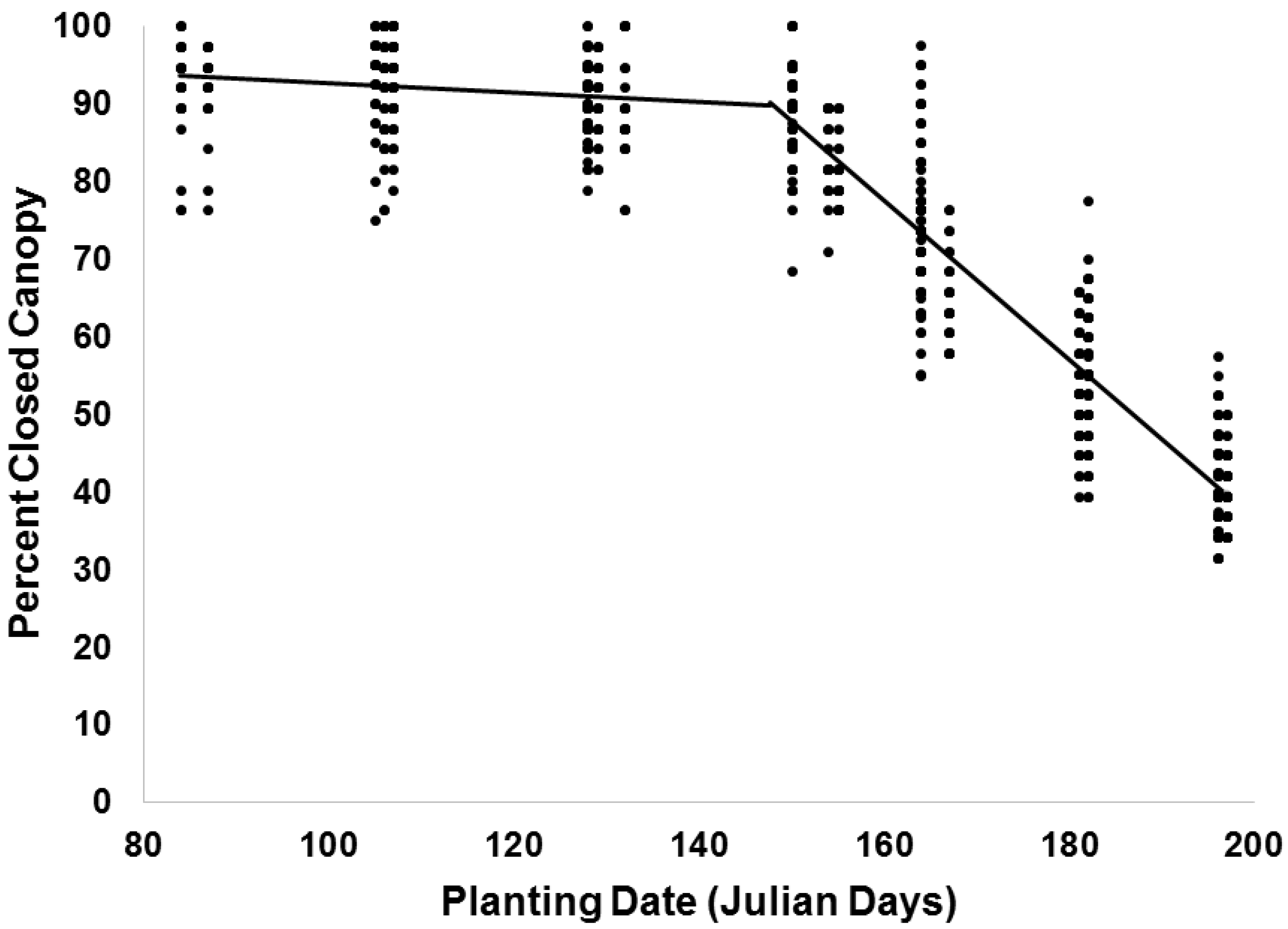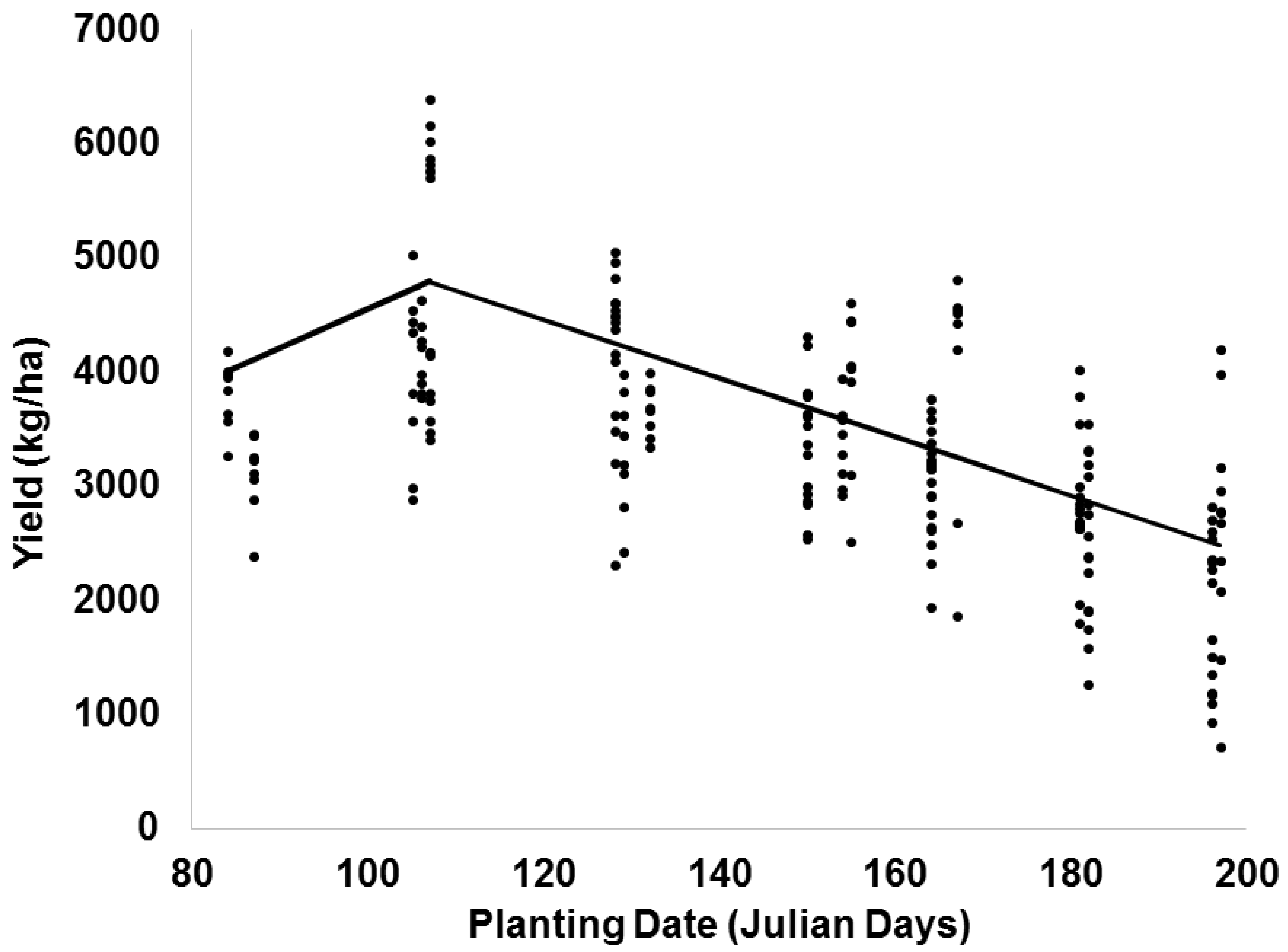Effects of Planting Date for Soybean Growth, Development, and Yield in the Southern USA
Abstract
1. Introduction
2. Materials and Methods
2.1. Location and Site Descriptions
2.2. Measurements
2.3. Statistical Analysis
3. Results and Discussion
3.1. Planting Date Effects on Insect Pressure
3.2. Planting Date Effects on Growth Stage
3.3. Planting Date Effects on Plant Height
3.4. Planting Date Effects on Canopy Closure
3.5. Planting Date Effects on Yield
3.6. Plant Height, Canopy Closure, Days to Growth Stages, and Insect Pressure Impact on Yield
4. Recommendations for Soybean Production Based on Planting Date
Author Contributions
Funding
Conflicts of Interest
References
- Hartman, G.L.; West, E.D.; Herman, T.K. Crops that feed the world 2. Soybean–worldwide production, use, and constraints caused by pathogens and pests. Food Secur. 2011, 3, 5–17. [Google Scholar] [CrossRef]
- NASS. Cropland Data Layer; United States Department of Agriculture–National Agricultural Statistics Service: Washington, DC, USA, 2014.
- Heatherly, L.G. Soybean Development in the Midsouthern USA Related to Date of Planting and Maturity Classification. Crop Manag. 2005, 4. [Google Scholar] [CrossRef]
- Bowers, G.R. An Early Soybean Production System for Drought Avoidance. J. Prod. Agron. 1995, 8, 112–118. [Google Scholar] [CrossRef]
- Carner, G.R.; Turnipseed, S.G.; Shepard, M. Seasonal Abundance of Insect Pests of Soybeans. J. Econ. Entomol. 1974, 67, 487–493. [Google Scholar] [CrossRef]
- Poston, D.H.; Nandula, V.K.; Griffin, R.M.; Shaw, D.R.; Smith, M.C. Weed control alternatives in very early–maturing Mississippi soybean. Crop Manag. 2007, 6, 6. [Google Scholar] [CrossRef]
- Tukamuhabwa, P.; Dashiell, K.E.; Nabasirye, M.; Rubaihayo, P. Determination of field yield loss and effect of environment on pod shattering in soybean. Afr. Crop Sci. J. 2002, 10, 203–209. [Google Scholar]
- Catchot, A.L.; Allen, C.; Cook, D.; Dodds, D.; Gore, J.; Irby, T.; Larson, E.; Layton, B.; Meyers, S.; Musser, F. Insect Control Guide for Agronomic Crops; Mississippit State Univeristy Extension Service: Mississippi State, MS, USA, 2016; p. 2471. [Google Scholar]
- Fehr, W.R.; Caviness, C.E.; Burmood, D.T.; Pennington, J.S. Stage of Development Descriptions for Soybeans, Glycine Max (L.) Merrill. Crop Sci. 1971, 11, 929–931. [Google Scholar] [CrossRef]
- Ryan, S.E.; Porth, L.S. A Tutorial on the Piecewise Regression Approach Applied to Bedload Transport Data; Gen. Tech. Rep. RMRS–GTR–189; U.S. Department of Agriculture, Forest Service, Rocky Mountain Research Station: Fort Collins, CO, USA, 2007; p. 41.
- Thomas, J.F.; Raper, C.D. Photoperiodic control of seed filling for soybeans. Crop Sci. 1976, 16, 667–672. [Google Scholar] [CrossRef]
- Zhang, G.; Du, W. The effects of daylength on the growth of soybean and the creation of wide–adaptation germplasm. Soybean Genet. Newslett. 1999, 26, N/A. [Google Scholar]
- Zhang, L.; Zhang, J.; Watson, C.E.; Kyei–Boahen, S. Developing phenological prediction tables for soybean. Crop Manag. 2004, 3, 3. [Google Scholar] [CrossRef]
- Bastidas, A.M.; Setiyono, T.; Dobermann, A.; Cassman, K.G.; Elmore, R.W.; Graef, G.L.; Specht, J.E. Soybean Sowing Date: The Vegetative, Reproductive, and Agronomic Impacts. Crop Sci. 2008, 48, 727–740. [Google Scholar] [CrossRef]
- Wilcox, J.R.; Sediyama, T. Interrelationships among height, lodging and yield in determinate and indeterminate soybeans. Euphytica 1981, 30, 323–326. [Google Scholar] [CrossRef]
- Beatty, K.D.; Eldridge, I.L.; Simpson, A.M. Soybean Response to Different Planting Patterns and Dates. Agron. J. 1982, 74, 859–862. [Google Scholar] [CrossRef]
- Sweeney, D.W.; Granade, G.V.; Burton, R.O. Early and traditionally maturing soybean varieties grown in two planting systems. J. Prod. Agron. 1995, 8, 373–379. [Google Scholar] [CrossRef]
- Taylor, H.M. Soybean growth and yield as affected by row spacing and by seasonal water supply. Agron. J. 1980, 72, 543–547. [Google Scholar] [CrossRef]
- Nordby, D.E.; Alderks, D.L.; Nafziger, E.D. Competitiveness with weeds of soybean cultivars with different maturity and canopy width characteristics. Weed Technol. 2007, 21, 1082–1088. [Google Scholar] [CrossRef]
- Egli, D.B.; Bruening, W.P. Potential of Early–Maturing Soybean Cultivars in Late Plantings. Agron. J. 2000, 92, 532–537. [Google Scholar] [CrossRef]
- Savoy, B.R.; Cothren, J.T.; Shumway, C.R. Early–season production systems utilizing indeterminate soybean. Agron. J. 1992, 84, 394–398. [Google Scholar] [CrossRef]
- Barreiro, A.S.; Godsey, C.B. Soybean Yield as Affected by Planting Date and Maturity Group in the Southern Plains. Crop Manag. 2013, 12, 12. [Google Scholar] [CrossRef]
- Egli, D.B.; Cornelius, P.L. A Regional Analysis of the Response of Soybean Yield to Planting Date. Agron. J. 2009, 101, 330–335. [Google Scholar] [CrossRef]
- Baur, M.E.; Boethel, D.J.; Boyd, M.L.; Bowers, G.R.; Way, M.O.; Heatherly, L.G.; Rabb, J.; Ashlock, L. Arthropod Populations in Early Soybean Production Systems in the Mid–South. Environ. Entomol. 2000, 29, 312–328. [Google Scholar] [CrossRef]
- McPherson, R.M.; Wells, M.L.; Bundy, C.S. Impact of the early soybean production system on arthropod pest populations in Georgia. Environ. Entomol. 2001, 30, 76–81. [Google Scholar] [CrossRef]
- Gore, J.; Abel, C.A.; Adamczyk, J.J.; Snodgrass, G. Influence of soybean planting date and maturity group on stink bug (Heteroptera: Pentatomidae) populations. Environ. Entomol. 2006, 35, 531–536. [Google Scholar] [CrossRef]
- Smith, J.F.; Luttrell, R.G.; Greene, J.K.; Tingle, C. Early–season soybean as a trap crop for stink bugs (Heteroptera: Pentatomidae) in Arkansas 8217; changing system of soybean production. Environ. Entomol. 2009, 38, 450–458. [Google Scholar] [CrossRef][Green Version]




| Starkville, MS | Stoneville, MS | |||
|---|---|---|---|---|
| 2013 | 2014 | 2013 | 2014 | |
| Planting Date | Date of Planting (Julian Date) | Date of Planting (Julian Date) | Date of Planting (Julian Date) | Date of Planting (Julian Date) |
| 1 | 3/28 (87) | 3/21 (80) * | 4/8 (98) * | 3/25 (84) |
| 2 | 4/17 (107) | 4/17 (107) | 4/15 (105) | 4/16 (106) |
| 3 | 5/9 (129) | 5/8 (128) | 5/8 (128) | 5/12 (132) |
| 4 | 5/30 (150) | 6/4 (155) | 5/30 (150) | 6/3 (154) |
| 5 | 6/13 (164) | 6/16 (167) | 6/13 (164) | 6/13 (164) |
| 6 | 7/1 (182) | 6/30 (181) | 7/1 (182) | 6/30 (181) |
| 7 | 7/15 (196) | 7/16 (197) | 7/15 (196) | 7/16 (197) * |
| Average Number of Days to Growth Stage (± SEM) † | |||
|---|---|---|---|
| Planting Date (Julian Day) | Emergence | Vegetative Period | Reproductive Period |
| 1 (80–98) | 10 (1) a | 36 (1) a | 78 (5) a |
| 2 (105–107) | 9 (0) a | 37 (2) a | 66 (4) b |
| 3 (128–132) | 9 (1) a | 30 (2) b | 63 (1) bc |
| 4 (150–155) | 6 (0) b | 33 (2) ab | 58 (4) bc |
| 5 (164–167) | 6 (1) b | 31 (2) b | 56 (1) c |
| 6 (181–182) | 6 (0) b | 32 (1) b | 46 (2) d |
| 7 (196–197) | 5 (0) b | 30 (3) b | 46 (3) d |
| p–value | <0.01 | <0.01 | <0.01 |
| LSD | 1.53 | 1.96 | 3.68 |
| Linear Term | ||||||
|---|---|---|---|---|---|---|
| Data Rated | BP † | Intercept (±SEM) | Estimate (±SEM ††) | t–Value | df | p–Value |
| Plant Heights | 153 | |||||
| Before BP | 51.7 (4.2) | 0.3 (0.03) | 13.4 | 369.3 | <0.01 | |
| After BP | 278.4 (6.0) | −1.1 (0.03) | −34.6 | 429.0 | <0.01 | |
| Canopy Closure | 147 | |||||
| Before BP | 99.9 (1.9) | −0.1 (0.02) | −4.7 | 334.0 | <0.01 | |
| After BP | 239.5 (4.3) | −1.0 (0.02) | −51.3 | 406.7 | <0.01 | |
| Yield | 110 | |||||
| Before BP | 1125.7 (861.0) | 34.3 (6.7) | 5.1 | 5.5 | 0.03 | |
| After BP | 7709.5 (422.1) | −26.6 (1.9) | −13.9 | 123.6 | <0.01 | |
© 2020 by the authors. Licensee MDPI, Basel, Switzerland. This article is an open access article distributed under the terms and conditions of the Creative Commons Attribution (CC BY) license (http://creativecommons.org/licenses/by/4.0/).
Share and Cite
Bateman, N.R.; Catchot, A.L.; Gore, J.; Cook, D.R.; Musser, F.R.; Irby, J.T. Effects of Planting Date for Soybean Growth, Development, and Yield in the Southern USA. Agronomy 2020, 10, 596. https://doi.org/10.3390/agronomy10040596
Bateman NR, Catchot AL, Gore J, Cook DR, Musser FR, Irby JT. Effects of Planting Date for Soybean Growth, Development, and Yield in the Southern USA. Agronomy. 2020; 10(4):596. https://doi.org/10.3390/agronomy10040596
Chicago/Turabian StyleBateman, Nick R., Angus L. Catchot, Jeff Gore, Don R. Cook, Fred R. Musser, and J. Trent Irby. 2020. "Effects of Planting Date for Soybean Growth, Development, and Yield in the Southern USA" Agronomy 10, no. 4: 596. https://doi.org/10.3390/agronomy10040596
APA StyleBateman, N. R., Catchot, A. L., Gore, J., Cook, D. R., Musser, F. R., & Irby, J. T. (2020). Effects of Planting Date for Soybean Growth, Development, and Yield in the Southern USA. Agronomy, 10(4), 596. https://doi.org/10.3390/agronomy10040596





